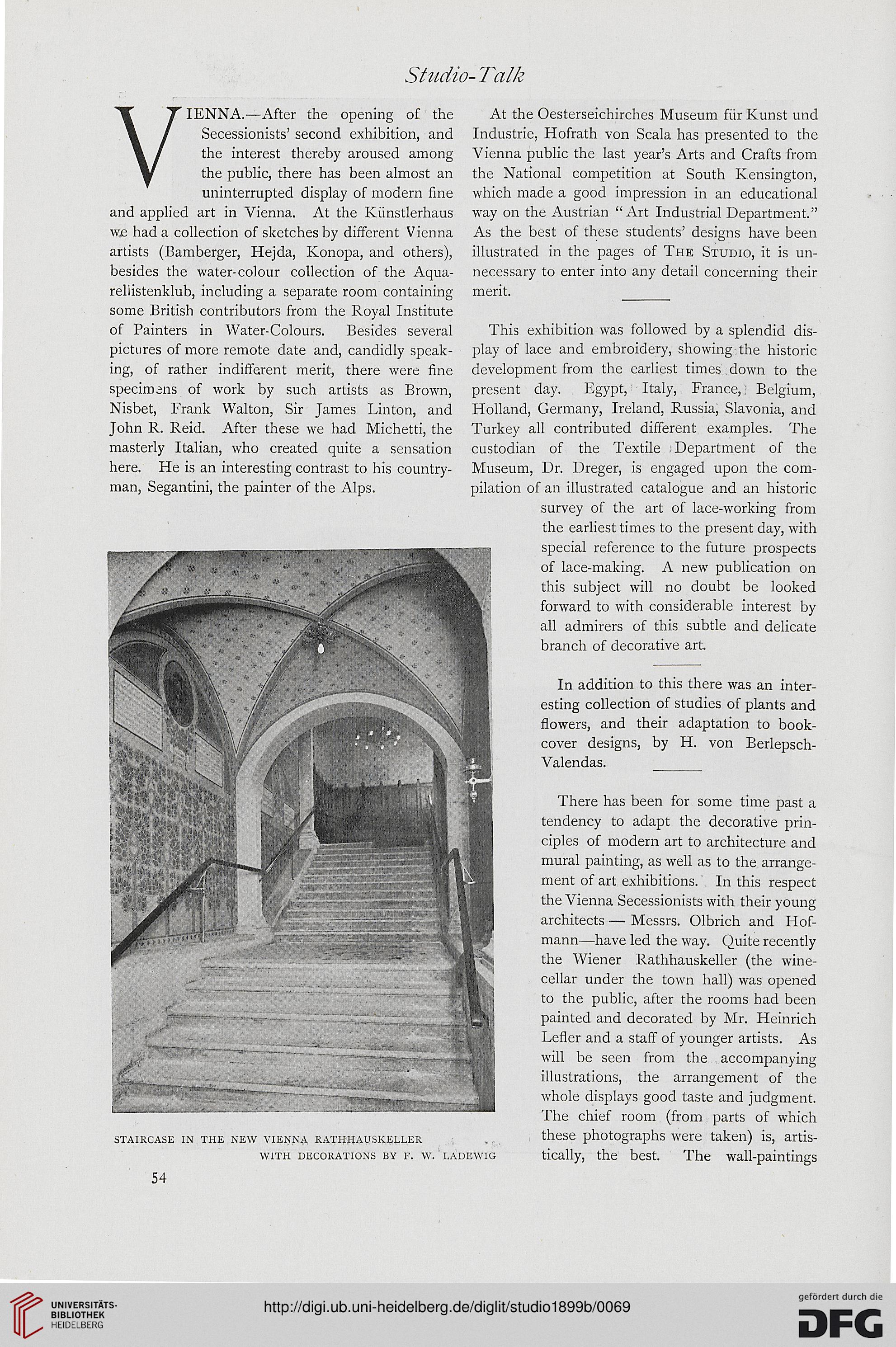Studio-Talk
VIENNA.—After the opening of the
Secessionists’ second exhibition, and
the interest thereby aroused among
the public, there has been almost an
uninterrupted display of modern fine
and applied art in Vienna. At the Kiinstlerhaus
wje had a collection of sketches by different V ienna
artists (Bamberger, Hejda, Konopa, and others),
besides the water-colour collection of the Aqua-
rellistenklub, including a separate room containing
some British contributors from the Royal Institute
of Painters in Water-Colours. Besides several
pictures of more remote date and, candidly speak-
ing, of rather indifferent merit, there were fine
specimens of work by such artists as Brown,
Nisbet, Frank Walton, Sir James Linton, and
John R. Reid. After these we had Michetti, the
masterly Italian, who created quite a sensation
here. He is an interesting contrast to his country-
man, Segantini, the painter of the Alps.
STAIRCASE IN THE NEW VIENNA, RATUHAUSKELLER
WITH DECORATIONS 1SY F. W. LADEWIG
At the Oesterseichirches Museum fiir Ivunst und
Industrie, Hofrath von Scala has presented to the
Vienna public the last year’s Arts and Crafts from
the National competition at South Kensington,
which made a good impression in an educational
way on the Austrian “Art Industrial Department.”
As the best of these students’ designs have been
illustrated in the pages of The Studio, it is un-
necessary to enter into any detail concerning their
merit.
This exhibition was followed by a splendid dis-
play of lace and embroidery, showing the historic
development from the earliest times down to the
present day. Egypt, Italy, France, Belgium,
Holland, Germany, Ireland, Russia, Slavonia, and
Turkey all contributed different examples. The
custodian of the Textile Department of the
Museum, Dr. Dreger, is engaged upon the com-
pilation of an illustrated catalogue and an historic
survey of the art of lace-working from
the earliest times to the present day, with
special reference to the future prospects
of lace-making. A new publication on
this subject will no doubt be looked
forward to with considerable interest by
all admirers of this subtle and delicate
branch of decorative art.
In addition to this there was an inter-
esting collection of studies of plants and
flowers, and their adaptation to book-
cover designs, by H. von Berlepsch-
Valendas.
There has been for some time past a
tendency to adapt the decorative prin-
ciples of modern art to architecture and
mural painting, as well as to the arrange-
ment of art exhibitions. In this respect
the Vienna Secessionists with their young
architects — Messrs. Olbrich and Hof-
mann—have led the way. Quite recently
the Wiener Rathhauskeller (the wine-
cellar under the town hall) was opened
to the public, after the rooms had been
painted and decorated by Mr. Heinrich
Lefler and a staff of younger artists. As
will be seen from the accompanying
illustrations, the arrangement of the
whole displays good taste and judgment.
The chief room (from parts of which
these photographs were taken) is, artis-
tically, the best. The wall-paintings
54
VIENNA.—After the opening of the
Secessionists’ second exhibition, and
the interest thereby aroused among
the public, there has been almost an
uninterrupted display of modern fine
and applied art in Vienna. At the Kiinstlerhaus
wje had a collection of sketches by different V ienna
artists (Bamberger, Hejda, Konopa, and others),
besides the water-colour collection of the Aqua-
rellistenklub, including a separate room containing
some British contributors from the Royal Institute
of Painters in Water-Colours. Besides several
pictures of more remote date and, candidly speak-
ing, of rather indifferent merit, there were fine
specimens of work by such artists as Brown,
Nisbet, Frank Walton, Sir James Linton, and
John R. Reid. After these we had Michetti, the
masterly Italian, who created quite a sensation
here. He is an interesting contrast to his country-
man, Segantini, the painter of the Alps.
STAIRCASE IN THE NEW VIENNA, RATUHAUSKELLER
WITH DECORATIONS 1SY F. W. LADEWIG
At the Oesterseichirches Museum fiir Ivunst und
Industrie, Hofrath von Scala has presented to the
Vienna public the last year’s Arts and Crafts from
the National competition at South Kensington,
which made a good impression in an educational
way on the Austrian “Art Industrial Department.”
As the best of these students’ designs have been
illustrated in the pages of The Studio, it is un-
necessary to enter into any detail concerning their
merit.
This exhibition was followed by a splendid dis-
play of lace and embroidery, showing the historic
development from the earliest times down to the
present day. Egypt, Italy, France, Belgium,
Holland, Germany, Ireland, Russia, Slavonia, and
Turkey all contributed different examples. The
custodian of the Textile Department of the
Museum, Dr. Dreger, is engaged upon the com-
pilation of an illustrated catalogue and an historic
survey of the art of lace-working from
the earliest times to the present day, with
special reference to the future prospects
of lace-making. A new publication on
this subject will no doubt be looked
forward to with considerable interest by
all admirers of this subtle and delicate
branch of decorative art.
In addition to this there was an inter-
esting collection of studies of plants and
flowers, and their adaptation to book-
cover designs, by H. von Berlepsch-
Valendas.
There has been for some time past a
tendency to adapt the decorative prin-
ciples of modern art to architecture and
mural painting, as well as to the arrange-
ment of art exhibitions. In this respect
the Vienna Secessionists with their young
architects — Messrs. Olbrich and Hof-
mann—have led the way. Quite recently
the Wiener Rathhauskeller (the wine-
cellar under the town hall) was opened
to the public, after the rooms had been
painted and decorated by Mr. Heinrich
Lefler and a staff of younger artists. As
will be seen from the accompanying
illustrations, the arrangement of the
whole displays good taste and judgment.
The chief room (from parts of which
these photographs were taken) is, artis-
tically, the best. The wall-paintings
54




